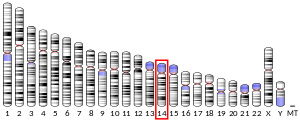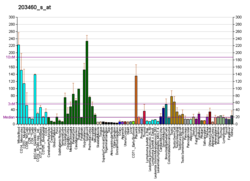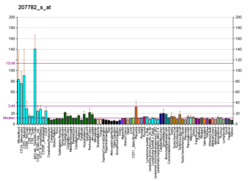プレセニリン1
プレセニリン1(英: presenilin-1、PS-1)は、ヒトではPSEN1遺伝子にコードされるプレセニリンタンパク質の1つである。プレセニリン1はγ-セクレターゼ複合体中の4つのコアタンパク質の1つであり、アミロイド前駆体タンパク質(APP)からアミロイドβ(Aβ)の産生に重要な役割を果たしていると考えられている。Aβの蓄積はアルツハイマー病の発症と関係している[5]。
構造
編集プレセニリンは9つの膜貫通ドメインを持ち、N末端は細胞質側、C末端は細胞外側に位置する[6][7]。プレセニリンにはタンパク質内部で切断によるプロセシングを受け、ヒトでは約27–28 kDaのN末端断片と約16–17 kDaのC末端断片が形成される[8]。そして主にN末端断片とC末端断片からなるヘテロ二量体として存在する[8]。プレセニリン1の過剰発現時には、全長タンパク質が不活性型として蓄積する[9]。断片へのγ-セクレターゼ阻害剤の結合に関するデータ[10]をもとに、切断されたプレセニリン複合体が活性型であると考えられている[11]。
機能
編集プレセニリンは、APPを切断する酵素であるγ-セクレターゼに影響を及ぼすことで、APPのプロセシングを調節していると考えられている。また、プレセニリンはNotch受容体の切断にも関与しており、γ-セクレターゼの活性を調節しているか、もしくはそれ自身がプロテアーゼとして作用している。PSEN1遺伝子には複数の選択的スプライシングバリアントが同定されているが、その性質が明らかとなっているのは一部のみである[12]。
Notchシグナル伝達経路
編集Notchシグナル伝達経路では、Notch受容体の成熟と活性化の過程で重要なタンパク質分解反応が起こる[13]。Notch1は細胞外に位置するサイト1(S1)で切断され、細胞表面にヘテロ二量体型受容体が形成される[14]。受容体の形成後、Notch1はさらにサイト3(S3)で切断され[15]、Notch1の細胞内ドメイン(NICD)が膜から放出される[16]。
プレセニリン1はこのタンパク質分解過程に重要な役割を果たすことが示されている。プレセニリンにヌル変異を有するショウジョウバエではNotchシグナル伝達は消失し、notch変異と類似した致死表現型が生じる。さらに哺乳類細胞では、プレセニリン1の欠乏によってNotchからのNICDの切断放出の欠陥が引き起こされる。この研究では、いくつかのγ-セクレターゼ阻害剤によっても同じ段階が遮断されることが示されている[17]。これらのデータは、プレセニリン1がNotchシグナル伝達に重要な役割を果たしていることを示唆している。
Wntシグナル伝達経路
編集Wntシグナル伝達経路は、胚発生やその後の発生過程におけるいくつかの重要な段階に関与していることが示されている。プレセニリン1は、Wntシグナル伝達経路の重要な構成要素であるβ-カテニンと複合体を形成し、安定化する[18]。プレセニリン1変異トランスジェニックマウスの脳では、変異型プレセニリン1はβ-カテニン複合体安定化能が低下し、β-カテニンの過剰な分解をもたらす[18]。
プレセニリン1はWntシグナル伝達経路の負の調節因子であると考えられており、またβ-カテニンのリン酸化にも関与していることが示されている[19]。β-カテニンはプレセニリン1と共役して、2つのキナーゼによる逐次的なリン酸化が行われる[19]。プレセニリン1の欠乏はこの一連のリン酸化の連係を切り離し、正常なWntシグナルの伝達を破壊する[19]。
臨床的意義
編集アミロイドβの産生
編集変異型プレセニリン1を過剰発現するトランスジェニックマウスは脳内でAβ42(43)の増加を示し、このことはプレセニリン1がAβの調節に重要な役割を果たしていること、そしてアルツハイマー病と深く関係していることを示唆している[20]。プレセリン1欠損マウス胚由来の培養神経細胞を用いて行われた実験では、プレセニリン1が存在しなくともα-セクレターゼとβ-セクレターゼによる切断は正常であることが示されている。一方、γ-セクレターゼによるAPPの膜貫通ドメインの切断は消失し、アミロイドペプチドは1/5に減少する。このことは、プレセニリン1の欠乏によってアミロイドの産生がダウンレギュレーションされること、そしてプレセニリン1の阻害がアルツハイマー病における抗アミロイド産生治療の手法の1つとなる可能性があることを示唆している[21]。アミロイドの産生におけるプレセニリン1の役割に関する幅広い研究によって、アルツハイマー病に対する我々の理解は深まっている[22][23]。
アルツハイマー病
編集家族性アルツハイマー病患者は、プレセニリンタンパク質(PSEN1、PSEN2)もしくはAPPに変異が存在する可能性がある。こうした疾患関連変異は、より長い形のAβ(アルツハイマー病患者でみられれるアミロイド沈着物の主成分)の産生の増加を引き起こす。こうした変異は稀な早発性のアルツハイマー病の原因となり、常染色体優性遺伝する[24]。
がん
編集プレセニリン1はアルツハイマー病のほか、がんでも重要であることが示されている。ヒトメラノーマに対して行われた広範囲の遺伝子発現解析研究ではメラノーマ細胞株は2種類に分類されており、プレセニリン1は一方ではダウンレギュレーションされているが、もう一方では過剰発現していることが示された[25]。多剤耐性がん細胞株に対して行われた他の研究では、がんの発生におけるプレセニリン1の役割が明らかにされた。多剤耐性細胞は、がんの化学療法の奏功に対する重要な因子となっている[26]。この研究では、Notch1細胞内ドメイン(N1IC)とプレセニリン1の発現の解析によって多剤耐性獲得の分子機構の探索が行われた。その結果、どちらのタンパク質もより高レベルで発現していること、そして多剤耐性と関係しているABCC1がN1ICによって調節されていることが示され、プレセニリン1とNotchシグナルによるABCC1の調節機構が示唆された[27]。
相互作用
編集プレセニリン1は次に挙げる因子と相互作用することが示されている。
出典
編集- ^ a b c GRCh38: Ensembl release 89: ENSG00000080815 - Ensembl, May 2017
- ^ a b c GRCm38: Ensembl release 89: ENSMUSG00000019969 - Ensembl, May 2017
- ^ Human PubMed Reference:
- ^ Mouse PubMed Reference:
- ^ “Cell biology of the amyloid beta-protein precursor and the mechanism of Alzheimer's disease”. Annu. Rev. Cell Biol. 10: 373–403. (1994). doi:10.1146/annurev.cb.10.110194.002105. PMID 7888181.
- ^ “A nine-transmembrane domain topology for presenilin 1”. J. Biol. Chem. 280 (42): 35352–60. (October 2005). doi:10.1074/jbc.M507217200. PMID 16046406.
- ^ “Building gamma-secretase: the bits and pieces”. J. Cell Sci. 121 (Pt 4): 413–20. (February 2008). doi:10.1242/jcs.015255. PMID 18256384.
- ^ a b “Endoproteolysis of presenilin 1 and accumulation of processed derivatives in vivo”. Neuron 17 (1): 181–90. (July 1996). doi:10.1016/S0896-6273(00)80291-3. PMID 8755489.
- ^ “Endoproteolytic processing and stabilization of wild-type and mutant presenilin”. J. Biol. Chem. 272 (39): 24536–41. (September 1997). doi:10.1074/jbc.272.39.24536. PMID 9305918.
- ^ “Photoactivated gamma-secretase inhibitors directed to the active site covalently label presenilin 1”. Nature 405 (6787): 689–94. (June 2000). Bibcode: 2000Natur.405..689L. doi:10.1038/35015085. PMID 10864326.
- ^ “Presenilin endoproteolysis is an intramolecular cleavage”. Mol. Cell. Neurosci. 29 (1): 65–73. (May 2005). doi:10.1016/j.mcn.2004.12.012. PMID 15866047.
- ^ “Entrez Gene: PSEN1 presenilin 1 (Alzheimer disease 3)”. 2023年2月25日閲覧。
- ^ “Roles for proteolysis and trafficking in notch maturation and signal transduction”. Cell 94 (4): 423–6. (August 1998). doi:10.1016/S0092-8674(00)81583-4. PMID 9727485.
- ^ “The Notch1 receptor is cleaved constitutively by a furin-like convertase”. Proc. Natl. Acad. Sci. U.S.A. 95 (14): 8108–12. (July 1998). Bibcode: 1998PNAS...95.8108L. doi:10.1073/pnas.95.14.8108. PMC 20937. PMID 9653148.
- ^ “Notch-1 signalling requires ligand-induced proteolytic release of intracellular domain”. Nature 393 (6683): 382–6. (May 1998). Bibcode: 1998Natur.393..382S. doi:10.1038/30756. PMID 9620803.
- ^ “Signalling downstream of activated mammalian Notch”. Nature 377 (6547): 355–8. (September 1995). Bibcode: 1995Natur.377..355J. doi:10.1038/377355a0. PMID 7566092.
- ^ “A presenilin-1-dependent gamma-secretase-like protease mediates release of Notch intracellular domain”. Nature 398 (6727): 518–22. (April 1999). Bibcode: 1999Natur.398..518D. doi:10.1038/19083. PMID 10206645.
- ^ a b “Presenilins are essential for regulating neurotransmitter release”. Nature 460 (7255): 632–6. (July 2009). Bibcode: 2009Natur.460..632Z. doi:10.1038/nature08177. PMC 2744588. PMID 19641596.
- ^ a b c “Presenilin couples the paired phosphorylation of beta-catenin independent of axin: implications for beta-catenin activation in tumorigenesis”. Cell 110 (6): 751–62. (September 2002). doi:10.1016/S0092-8674(02)00970-4. PMID 12297048.
- ^ “Increased amyloid-beta42(43) in brains of mice expressing mutant presenilin 1”. Nature 383 (6602): 710–3. (October 1996). Bibcode: 1996Natur.383..710D. doi:10.1038/383710a0. PMID 8878479.
- ^ “Deficiency of presenilin-1 inhibits the normal cleavage of amyloid precursor protein”. Nature 391 (6665): 387–90. (January 1998). Bibcode: 1998Natur.391..387D. doi:10.1038/34910. PMID 9450754.
- ^ “Presenilin 1 stabilizes the C-terminal fragment of the amyloid precursor protein independently of gamma-secretase activity”. J. Biol. Chem. 279 (24): 25333–8. (June 2004). doi:10.1074/jbc.M312710200. PMID 15087467.
- ^ “GSK-3alpha regulates production of Alzheimer's disease amyloid-beta peptides”. Nature 423 (6938): 435–9. (May 2003). Bibcode: 2003Natur.423..435P. doi:10.1038/nature01640. PMID 12761548.
- ^ “Epidemiology of Alzheimer disease”. Cold Spring Harbor Perspectives in Medicine 2 (8): a006239. (2012). doi:10.1101/cshperspect.a006239. PMC 3405821. PMID 22908189.
- ^ “Two types of human malignant melanoma cell lines revealed by expression patterns of mitochondrial and survival-apoptosis genes: implications for malignant melanoma therapy”. Mol. Cancer Ther. 8 (5): 1292–304. (May 2009). doi:10.1158/1535-7163.MCT-08-1030. PMC 3128982. PMID 19383853.
- ^ “Multidrug resistance in cancer: role of ATP-dependent transporters”. Nat. Rev. Cancer 2 (1): 48–58. (January 2002). doi:10.1038/nrc706. PMID 11902585.
- ^ “Notch1 regulates the expression of the multidrug resistance gene ABCC1/MRP1 in cultured cancer cells”. Proc. Natl. Acad. Sci. U.S.A. 108 (51): 20778–83. (December 2011). Bibcode: 2011PNAS..10820778C. doi:10.1073/pnas.1019452108. PMC 3251103. PMID 22143792.
- ^ “Presenilin 1 protein directly interacts with Bcl-2”. J. Biol. Chem. 274 (43): 30764–9. (October 1999). doi:10.1074/jbc.274.43.30764. PMID 10521466.
- ^ “Abrogation of the presenilin 1/beta-catenin interaction and preservation of the heterodimeric presenilin 1 complex following caspase activation”. J. Biol. Chem. 273 (51): 33909–14. (December 1998). doi:10.1074/jbc.273.51.33909. PMID 9852041.
- ^ “Presenilin 1 facilitates the constitutive turnover of beta-catenin: differential activity of Alzheimer's disease-linked PS1 mutants in the beta-catenin-signaling pathway”. J. Neurosci. 19 (11): 4229–37. (June 1999). doi:10.1523/JNEUROSCI.19-11-04229.1999. PMC 6782616. PMID 10341227.
- ^ “Direct association of presenilin-1 with beta-catenin”. FEBS Lett. 433 (1–2): 73–7. (August 1998). doi:10.1016/S0014-5793(98)00886-2. PMID 9738936.
- ^ “Isolation of human delta-catenin and its binding specificity with presenilin 1”. NeuroReport 10 (3): 563–8. (February 1999). doi:10.1097/00001756-199902250-00022. PMID 10208590.
- ^ Levesque G (1999). “Presenilins interact with armadillo proteins including neural-specific plakophilin-related protein and beta-catenin.”. Journal of Neurochemistry 72 (3): 999–1008. doi:10.1046/j.1471-4159.1999.0720999.x. PMID 10037471.
- ^ “Interaction of presenilins with the filamin family of actin-binding proteins”. J. Neurosci. 18 (3): 914–22. (February 1998). doi:10.1523/JNEUROSCI.18-03-00914.1998. PMC 2042137. PMID 9437013.
- ^ “A new splice variant of glial fibrillary acidic protein, GFAP epsilon, interacts with the presenilin proteins”. J. Biol. Chem. 277 (33): 29983–91. (August 2002). doi:10.1074/jbc.M112121200. PMID 12058025.
- ^ “Interaction with telencephalin and the amyloid precursor protein predicts a ring structure for presenilins”. Neuron 32 (4): 579–89. (November 2001). doi:10.1016/S0896-6273(01)00512-8. PMID 11719200.
- ^ “Calsenilin: a calcium-binding protein that interacts with the presenilins and regulates the levels of a presenilin fragment”. Nat. Med. 4 (10): 1177–81. (October 1998). doi:10.1038/2673. PMID 9771752.
- ^ “Isolation and characterization of novel presenilin binding protein”. J. Neurochem. 75 (1): 109–16. (July 2000). doi:10.1046/j.1471-4159.2000.0750109.x. PMID 10854253.
- ^ “Nicalin and its binding partner Nomo are novel Nodal signaling antagonists”. EMBO J. 23 (15): 3041–50. (August 2004). doi:10.1038/sj.emboj.7600307. PMC 514924. PMID 15257293.
- ^ “Functional gamma-secretase complex assembly in Golgi/trans-Golgi network: interactions among presenilin, nicastrin, Aph1, Pen-2, and gamma-secretase substrates”. Neurobiol. Dis. 14 (2): 194–204. (November 2003). doi:10.1016/S0969-9961(03)00123-2. PMID 14572442.
- ^ “APH-1 interacts with mature and immature forms of presenilins and nicastrin and may play a role in maturation of presenilin.nicastrin complexes”. J. Biol. Chem. 278 (9): 7374–80. (February 2003). doi:10.1074/jbc.M209499200. PMID 12471034.
- ^ “Mammalian APH-1 interacts with presenilin and nicastrin and is required for intramembrane proteolysis of amyloid-beta precursor protein and Notch”. J. Biol. Chem. 277 (47): 45013–9. (November 2002). doi:10.1074/jbc.M208164200. PMID 12297508.
- ^ “Nicastrin modulates presenilin-mediated notch/glp-1 signal transduction and betaAPP processing”. Nature 407 (6800): 48–54. (September 2000). Bibcode: 2000Natur.407...48Y. doi:10.1038/35024009. PMID 10993067.
- ^ “Direct interaction of Alzheimer's disease-related presenilin 1 with armadillo protein p0071”. J. Biol. Chem. 274 (14): 9141–8. (April 1999). doi:10.1074/jbc.274.14.9141. PMID 10092585.
- ^ “Identification of ubiquilin, a novel presenilin interactor that increases presenilin protein accumulation”. J. Cell Biol. 151 (4): 847–62. (November 2000). doi:10.1083/jcb.151.4.847. PMC 2169435. PMID 11076969.
関連文献
編集- “The presenilin genes: a new gene family involved in Alzheimer disease pathology”. Hum. Mol. Genet. 5 Spec No: 1449–55. (1997). doi:10.1093/hmg/5.Supplement_1.1449. PMID 8875251.
- “Presenilin mutations in Alzheimer's disease”. Hum. Mutat. 11 (3): 183–90. (1998). doi:10.1002/(SICI)1098-1004(1998)11:3<183::AID-HUMU1>3.0.CO;2-J. PMID 9521418.
- “Clinical phenotypic heterogeneity of Alzheimer's disease associated with mutations of the presenilin-1 gene”. J. Neurol. 253 (2): 139–58. (2006). doi:10.1007/s00415-005-0019-5. PMID 16267640.
- “When loss is gain: reduced presenilin proteolytic function leads to increased Aβ42/Aβ40. Talking Point on the role of presenilin mutations in Alzheimer disease”. EMBO Rep. 8 (2): 136–40. (2007). doi:10.1038/sj.embor.7400896. PMC 1796780. PMID 17268504.
- “Loss-of-function presenilin mutations in Alzheimer disease. Talking Point on the role of presenilin mutations in Alzheimer disease”. EMBO Rep. 8 (2): 141–6. (2007). doi:10.1038/sj.embor.7400897. PMC 1796779. PMID 17268505.





